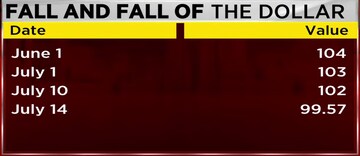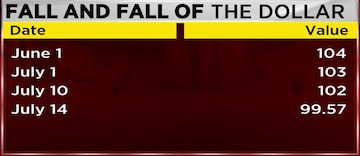The dollar index and treasury yields again fell last week, with new US inflation data showing a slowdown in the seemingly relentless rise of consumer prices.
The US
Consumer Price Index (CPI) gained just 0.2 percent last month, the Labor Department said on Wednesday (July 12), lifted by rises in gasoline prices as well as rents, which offset a decrease in the price of used motor vehicles.
However, the big story has been the fall and fall of the dollar index. From 104 in early July to 99.57 on July 14 — the triggers were lower-than-expected US CPI and PPI.
Separately, China's growth story remains disappointing, leading to a steady fall in the yuan. China's economy grew 6.3 percent in the April-June quarter of the current financial year. The 6.3 percent growth in China’s gross domestic product in April-June outpaced the 4.5 percent growth in the previous quarter, according to government data released on Monday, July 17. In quarterly terms, the economy grew 0.8 percent compared to the first three months of the year.
The Chinese yuan has been depreciating against the dollar and the rupee since May.
What will be the impact of this on the rupee and Indian equities?
According to Sameer Goel, Global Head of Emerging Markets & APAC Research at Deutsche Bank, the disinflation process is happening in a relatively benign manner as it's still set against the backdrop of a resilient US economy.
"Our view is that this hike in July will be at the peak. But that certainly (depends on) how long the Fed keeps that optionality open ... that will probably determine whether we can move beyond this brink of 100 into a bigger move ... potentially down to 95 levels, I think that will still remain pending, (awaiting a) clearer sort of a signal from the Fed," he added.
Additionally, while this number for the US dollar index and the S&P-500 is 0.71, it is just a tad lower at 0.67 for the Nifty. What this means is, when the dollar index rises, so do stocks.
Another argument supports the theory of some emerging markets (EM), even Indian equities, gaining at a time of dollar depreciation at the cost of US equities. While there can be some truth to this in terms of global fund allocations and weight changes in portfolios, to think that EM equities can rally while US equities sulk is a misperception.
Read more for in-depth understanding here.
According to B. Prasanna, Head, Global Markets Group at ICICI Bank, any immediate move in the dollar index is overdone in the short term. "Typically, the dollar tends to do well into extremes. Either they do well, when there is a crash in the economy due to some kind of a crisis or the US is doing really well. I think we've not had either of these situations and we kind of have a very nice slowdown in growth rather than a crash landing and the fact that inflation is also being controlled, kind of leads to the risk sentiment indicators improving and that's the reason why we find the dollar kind of depreciating against all other currencies," he added.
RBI holds the cards
He added that the RBI is maintaining an aggressive range on rupee vs dollar. Prasanna said in this case, the entire action on the dollar weakness story has been taken up by all the other G3 and G7 currencies. And it's hardly touched the rupee. The primary reason is, of course, that RBI has been aggressively maintaining range — you can call that range as 82 to 83 very broadly, he said.
"I would suspect that there should be an appreciation pressure if left on its own. And with the kind of FPI flows and the flows that emerging markets and India is getting, we should be appreciating, but I think RBI holds all the cards and they have proved to the market that they can keep it constant. So it is pretty much a call on when to think RBI lets it go. And at this point, since the yuan is depreciating it's all the more reason that RBI will be reluctant to let the rupee appreciate," he added.
(Edited by : Shoma Bhattacharjee)
First Published: Jul 17, 2023 5:39 PM IST





